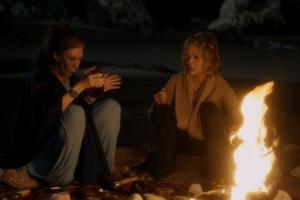When the Netflix comedy Grace and Frankie was renewed for a second season quickly after its premiere, I said to myself, let it rain. Let me explain.
Created by Marta Kauffman, a co-creator of Friends, the series begins with just a pitter-patter and grows into a Goliath of a downpour. By the time I finished the third episode of Grace and Frankie I was ready to go into the eye of the storm.
In the opening scene, when the eccentric, hippie painter who teaches art to ex-cons, Frankie Bergstein (Lily Tomlin), and uptight, former CEO of a cosmetics line, Grace (Jane Fonda), meet at a restaurant for lunch, they are told by their law-partner husbands Sol Bergstein (Sam Waterston) and Robert Hanson (Martin Sheen) that they are leaving their wives to marry each other. The premise was a lot to digest, especially since I had only invested a few minutes in these characters. I wasn’t able to feel any sympathy for this exceptionally heavy, life-changing news. But at that moment, I must admit that I was on the edge of my seat to see how these emotionally wounded septuagenarians would treat each other once they left the restaurant.

Everyone in the family must adjust and give up their entire lives. While we get a taste of how both couples’ children (Brooklyn Decker, June Diane Raphael, Ethan Embry, and Baron Vaughn) deal with the shift in familial dynamics and learn a bit about their backstories, they just didn’t prove as interesting as watching Fonda and Tomlin go through various stages of grief. Strangely enough, while the show’s core storyline of two older gay men who want to begin a new life is one of the ripest story lines on TV, the relationship between Sheen and Waterston (left), more times than not, proves to be a distraction. Something about their professed love feels forced amid some very funny moments between Fonda and Tomlin. While Waterston does provide some sincere moments and fine acting, I just couldn’t co-sign on the relationship deal.
When Fonda and Tomlin find a safe haven in the beach house that the couples purchased jointly, it’s there that the calm after the storm feels very comfortable.
The duo’s time spent together is full of self-realizations, surprise revelations, some purposeful shoplifting, and a little peyote smoking on the beach (below right). Both break the seal of destiny as to how they will live out their lives and realize and revel in the fact that what has torn their families apart is also the tie that binds them. The pair discover they have so much in common it doesn’t make sense to be by themselves and when they finally accept the inevitability of their friendship, Fonda and Tomlin deliver. They are funny, smart, and sexy. Yes, they are sexy - and they have sex. It’s a friendship between two older women that is under-examined and undervalued in the media.

The afternoon I binged on the show, I thanked the producers for making each episode just a half-hour. It allowed me to take in all 13 episodes - twice. As I watched, I never lost interest thanks in part to guest appearances by Ernie Hudson and Joe Morton. But it was Craig T. Nelson who, with ease, comes on the scene as Jane Fonda’s love interest bringing a fresh look to a man who is passionate, sexy, in his 70s, and in love. When he says, “I’m trying to tell you something here. I’m falling in love with you,” I’m there.
And I’ll be there for the second season, but it will be with great hope that the writers spend more time studying the characters of Grace and Frankie as they recalibrate their emotions while they watch their husbands prepare to walk down the aisle. What they represent is exceptionally powerful because in their pain they seem to realize that they want to be happy and have a man in their lives, but don’t need a man to be happy. It’s a formula that worked for The Golden Girls 30 years ago, and one that will make Grace & Frankie golden. I say, let it rain.